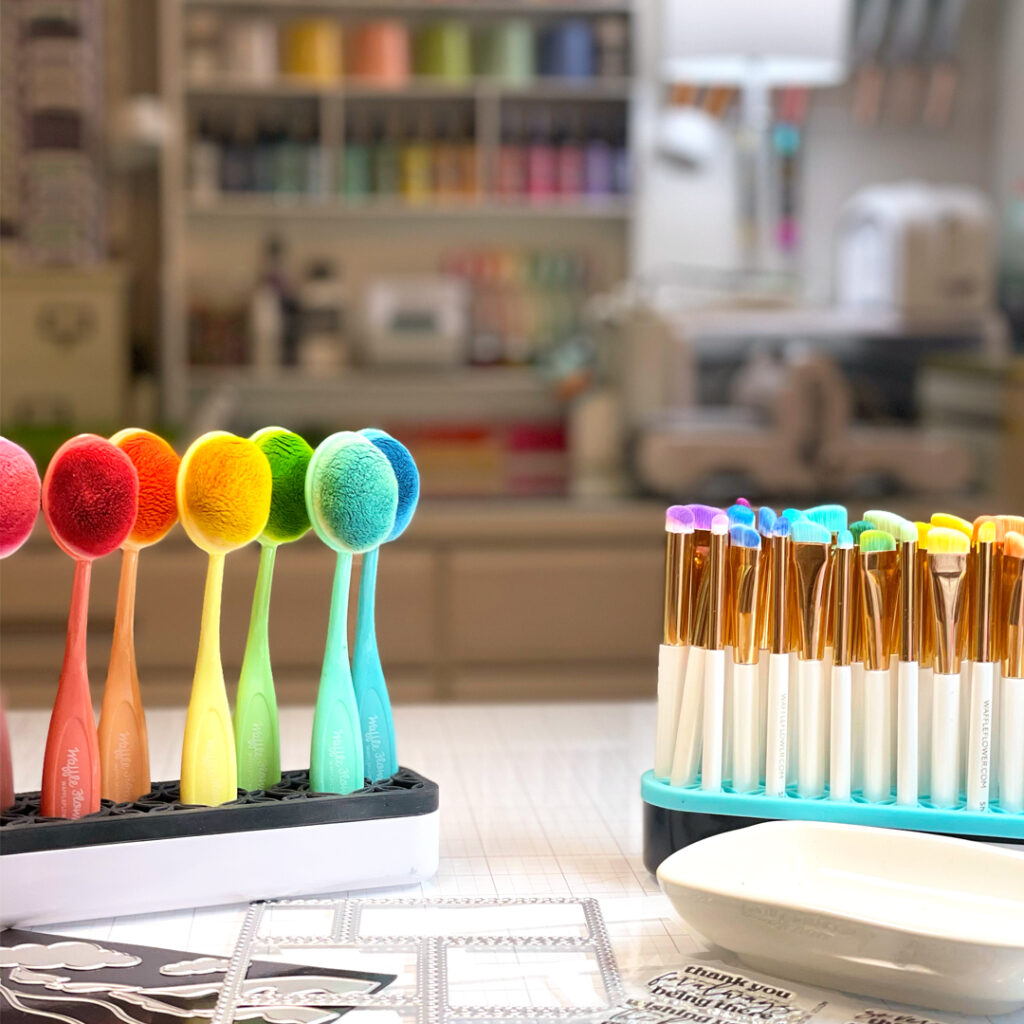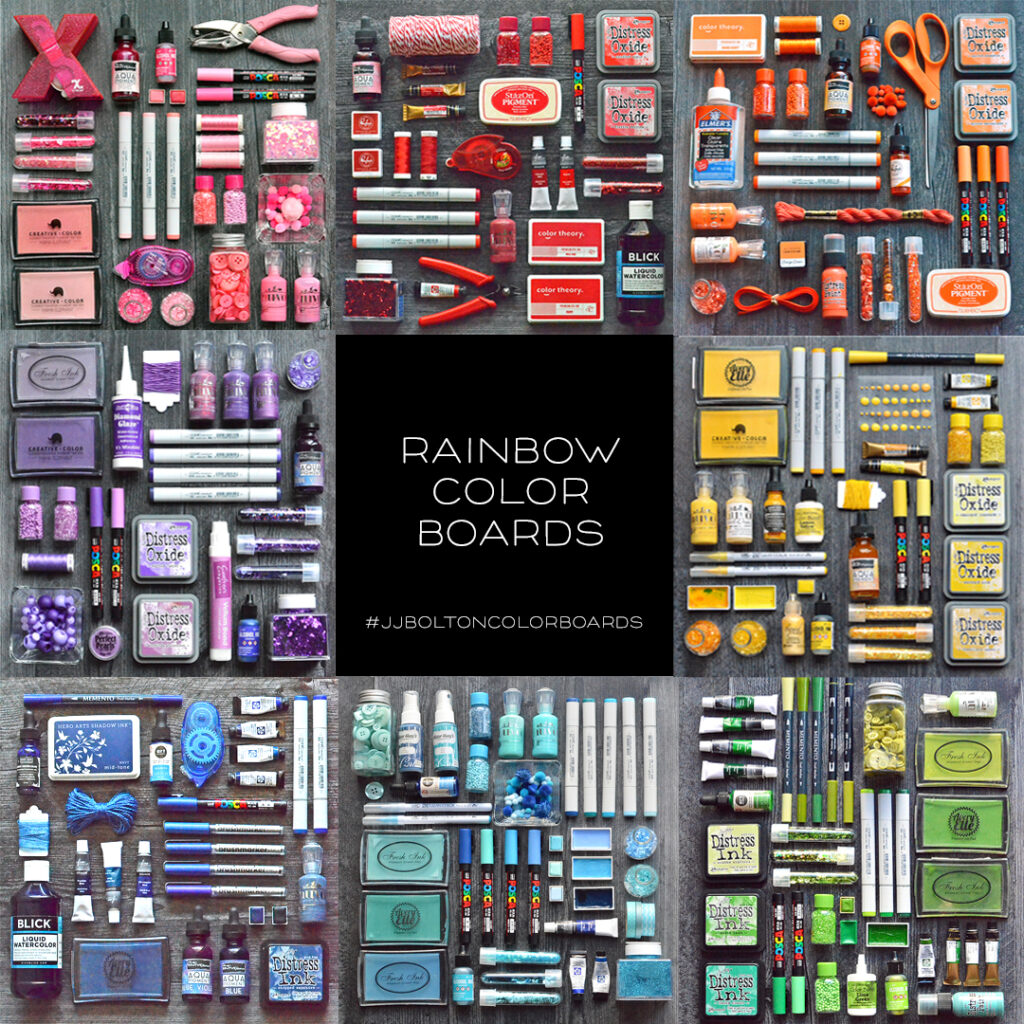{2024}
After many years of planning and saving, I completed a big update of my craft/office by converting the front living room of our house in 2023. I traded in most of my IKEA furniture for built-ins that were designed to fit the space. After over a decade of paper crafting, my ideas of an ideal craft room have changed and when I started planning for this room, I had a list of “musts” in mind to make my craftroom easier to use. The top “musts” were:
- Deep storage with doors – The open IKEA Billy bookcases that I used before were very shallow (only about 11″ deep). I had some doors for the bookcases, but most of the shelving was open. I really wanted closed storage to keep things looking neat and to protect everything from dust and light.
- Heavy duty drawers – Instead of storing stamp sets in bins, I wanted deep drawers with dividers to store stamps, dies, and foil plates. Bins are nice, but my collection is always changing and drawers are more flexible.
- Built-in desk – In addition to my design work, I work from home for my regular job. A permanent desk with a large open desk space for multiple computers and monitors was important to me. I also wanted an area to store my business files and personal mail.
- Flexible Design – I’m not looking to move soon, but I did want to make upgrades that would work with the rest of the house and work for the future owners of the house. The built-ins blend in with the rest of my house and do not look like kitchen cabinets (which was super important to me). The layout works for an office, but would also work for a living room or family room.
Here’s a general layout of my room with the built-ins shown in beige and the rest of the non-permanent furniture in white:

Here’s some pics of the major areas of the room:






Craft Island



The center of the room is the IKEA kitchen island (Tornviken) that I had in my previous office. This piece is the perfect height, stores a ton, and can be easily moved. Instead of putting heavy casters on the island, I have it on furniture slides. I was worried about drilling casters into the legs of the island and didn’t want the extra height casters would add. The sliders make it easy to move to the side if I need extra floor space. On top of the island, I keep a lazy Susan with all my must-have tools. The surface is mostly covered with an XL glassboard from Glassboard Studio in white.
Built-in Cabinets & Drawers


The built-ins run along the short end of the room and includes two tall cabinets flanking a recessed nook with a counter and 6 drawers. The counter area is 24″ deep by 60″ wide which allows room for storing items and working. Before the built-ins were installed, I got an electrical plug installed in the nook area for all my electrical needs (lamp, Glimmer machine, Empress machine). This nook houses items I like to display and tools that I use daily such as my cutting machines, paper trimmer, embossing gun, and glimmer machine. This counter area is where I do all my die cutting, paper trimming, and foiling.




Under the nook counter are two shallow drawers and 4 deep drawers. The two shallow drawers have my favorite inks (left drawer) and my die cutting tools and grip mats (right drawer). All of the deep drawers have adjustable dividers for filing storage sleeves filled with stamps, dies, and foil plates. I file products by category/topic (such as flowers, love, masculine, etc.) not vendor except for my Waffle Flower and Papertrey Ink goodies. I have various subcategories and use plastic file tabs to separate sections.



On each side of the nook area is a tall cabinet with double doors. They are a full 24″ deep and the lower shelves pull out to make things in the back easier to access. The sliding hardware is sturdy and can accommodate heavy papers and supplies. Since the cabinets are so deep, I can store two rows of items in bins or containers. To make sure nothing got lost in all the closed storage, I first decluttered, sorted, and then gathered like items in appropriately-sized bins. When everything was put into the cabinets, I created a simple diagram listing what is on each shelf (have this posted at my desk and on the computer).
In the left cabinet, I keep the following items (from top to bottom):
- Craft “appliances” – Minc machine, camera, Cricut iron, etc.
- Craft supplies – Glue gun and sticks, twines/thread, felt, glitters, foam, sprays, foil, powders, sealing wax, etc.
- Craft tools – Magnetic mat, stamping platforms, embossing folders, misc. stencils, paintbrushes, etc.
- Watercolors and paints
- Extra storage supplies – Test tubes, racks, organizing trays, etc.
In the right cabinet, I keep the following items (from top to bottom):
- Envelopes and gift bags
- Cardstock – Extra cardstock storage, specialty cardstock (glitter, metallic, etc.), Yupo, woodgrain paper
- Patterned Paper – Loose and small paper pads
- Ink pad reinkers
- Watercolor and art paper pads
- Various other items that need to lay flat – magnet sheets, acetate, vellum, sticker paper


Along the front wall of my office, I have movable/non-permanent furniture. This includes an IKEA Alex set of drawers that holds my cutting supplies like mats and rolls of media. I also keep various electronics for my office. On top of the Alex, I have an IKEA hutch that holds items that I like to keep handy (these change from time to time). I also have my collection of pigment ink pads (Amuse, Avery Elle, Mama Elephant) and my test tube racks filled with small items like sequins and gems.



On this wall, I also have an IKEA Raskog cart, IKEA coffee table cart, and 2 tall drawer units from Michaels. In the IKEA Raskog cart, I keep my markers, pens, and paints. I usually color sitting down, so the cart is easy to move to the desk or into the dining room if I have crafty friends visiting. On the low IKEA coffee table (discontinued), I hold my cutting machines (easy to pull it out to cut). In the tall drawer units from Michaels, I have various supplies that I access often and like to store in one layer. I’m gradually using up what is in these towers and will get rid of them some day. For now, they hold my Distress Oxide and Distress ink pads. I like that I can easily pull out the drawer and bring it wherever I want to use the ink pads.
Desk



The last area in the room is the built-in desk area. I spend a lot of time here designing as well as working from home for my regular job as a scientist. I love having room for all my computers, monitors, and printer. Above my desk is extra display and storage on an IKEA peg board.
On the left side of the desk, there is a set of narrow drawers for my crafty stuff. These are the items that I use for detailed work that I do when sitting at the desk. I also keep a variety of supplies such as enamel dots, foam strips, shaker covers, etc. On the right side of the desk is a wider set of drawers for my business and personal paperwork.
Craftroom Planning Tips
We’ve reached the end of the tour but before I go, I wanted to share some lessons I learned over the years about setting up a craftroom:
- Declutter, declutter, declutter – I cannot stress this enough. After almost 15 years of paper crafting, I know myself better and I buy what I use. In the past, I bought tons of stuff that I admired but was just not my style. Before I upgraded my office, I did a deep declutter and donated lots of stuff to those who will actually enjoy them. I still keep a bin in the corner of the room to gather things for giving away.
- Plan before you buy or build – Before a single piece of furniture comes home or one container is purchased, plan out where each item will live and what it will contain. This detailed planning saved me the headache of trying to make my supplies fit into spaces that were too big/too small, too messy, too out of sight, too far from my workspace, etc.
- Be prepared – Take good measurements of your space as well as dimensions of the items you want to store. Keep these measurements handy when you’re shopping so you don’t have to guess if something will fit. On a related note, don’t buy tapered bins (trust me).
- Buy in bulk but only if it matters – If you are worried about items matching, try to buy them at the same time. Sometimes companies (even IKEA) will slightly change a product over time or there may be small differences between production batches. If having an exact match matters to you, don’t wait.
- Leave room to grow – As hard as it is, try to resist the urge to fill every empty space. Extra room allows you to add without feeling overwhelmed or to rearrange when your needs and interests change. Extra room will also allow you to save money if you buy items in bulk.
- Don’t save for a rainy day – I can honestly say that nothing in my craftroom is off limits. It is important to me to have a room that can be used and enjoyed. I don’t hoard or save any supplies that I can use and enjoy today.
- Love your space as is – Don’t expect your craft space to look like the spaces of folks who craft for a living. When the twins were little, we lived in a tiny condo and all my crafting was done out of a plastic tote at the kitchen table. Over time, my craft area has grown and shrunk to accommodate the twists and turns of life (new houses, kids growing up and then going off to college, my dad moving in with us), but each room served its purpose at the time.
{2021}




My current craftroom is in our new empty-nesters house. This house does not have a main floor office like our old house. It has a lovely room in the basement with french doors and a window that would make a perfect craft office, but I use my space so much and I prefer to be in the middle of things. So we changed things up and put my office in the what was a smallish dining room. Since we have a huge formal dining table, we moved that to what was the front formal living room (which we never used). Total win-win!
Since this is not our forever house, I decided to just use my existing furniture and it fits fairly well. There’s a wall of bookshelves with some closed storage, a desk by the window, and a standing height work table against the other wall. In the middle of the room is my work table. In 2021, I upgraded my table to a kitchen island. The Ikea Tornviken fits the space perfectly, is standing height, and has storage. I’ve also made small improvements like adding a lazy susan for my most-used items and a rack to hold cutting mats, die cutting plates, and more.
Sources:
– Work Table – Ikea Tornviken
– Mini Trash Can – LotsaStyle Mini Countertop Wastebasket
– Rainbow Cart – Michaels Rolling Cart
{2016}




In this iteration of my craftroom, I made a bunch of changes to how I was storing small items. I went with some very visible storage solutions and I love seeing all the color.
One change was putting small sequins, embellishments, etc., in small plastic test tubes and storing them in test tube racks. I’m a scientist by day, so this storage option is normal for me. I also used some old beakers for storing pompoms, pens, etc. I also display my glitter in teeny volumetric flasks. While you may not go for the science theme like I have, I do encourage you to find a way to display your colorful supplies that fits your taste.
{2014}





This craftroom was in our house that had a main level office. Someday when we move to our forever home (when we retire), I’ll definitely recreate this space. This room was furnished with a mixture of Ikea furniture and cabinets that I got from my dad.
My work table is made with a wood door on top of those cabinets from my dad. The cabinets were from a sewing store going out of business and they were used to store sewing patterns. These painted metal cabinets are strong and hold a ton. I don’t have the room in my current space, but they are in the garage waiting to be powder-coated in a pretty color some day.
One of my best purchases was the little rolling metal table that I use for my cutting machines. It has wheels so I can easily pull away from the wall while I’m cutting and the smooth tops do not catch on the cutting mats while they’re moving. (They were from Ikea but are no longer available.)
Speaking of Ikea, I store my Copics in the top of my Raskog cart. I like being able to pull the cart to wherever I want to color. It fits right under my work table.
Sources:
– Ink Pad Racks – OrganizeMore 60 Standard Ink Organizer
– Copics Cart – Ikea Råskog
– Electronic Cutter Cart – Ikea PS 2012 (discontinued), similar item Ikea Tingby





